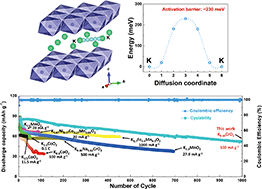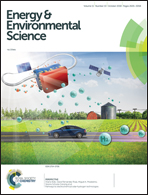Development of P3-K0.69CrO2 as an ultra-high-performance cathode material for K-ion batteries†
Abstract
Potassium-ion batteries (KIBs) are emerging as a promising energy storage technology because of their low cost and high energy density. However, the large size of K+ ions hinders the reversible electrochemical potassium (de)insertion in the host structure, limiting the selection of suitable electrode materials for KIBs. Herein, we designed and exploited a new layered oxide, P3-type K0.69CrO2 (hereafter denoted as P3-K0.69CrO2), as a high-performance cathode for KIBs for the first time. The proposed P3-K0.69CrO2 cathode was successfully synthesized via an electrochemical ion-exchange route and exhibited the best cycling performance for a KIB cathode material to date. A combination of electrochemical profiles, ex situ X-ray diffraction, and first-principles calculations was used to understand the overall potassium storage mechanism of P3-K0.69CrO2. Based on a reversible phase transition, P3-K0.69CrO2 delivers a high discharge capacity of 100 mA h g−1 and exhibits extremely high cycling stability with ∼65% retention over 1000 cycles at a 1C rate. Moreover, the K-ion hopping into the P3-K0.69CrO2 structure was extremely rapid, resulting in great power capability of up to a 10C rate with a capacity retention of ∼65% (vs. the capacity at 0.1C).



 Please wait while we load your content...
Please wait while we load your content...